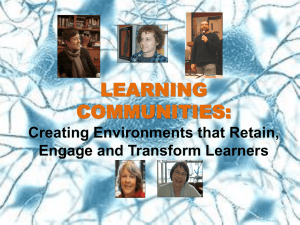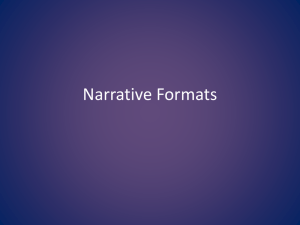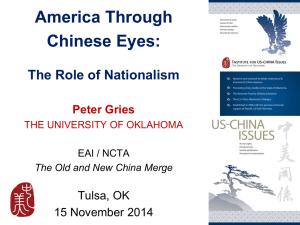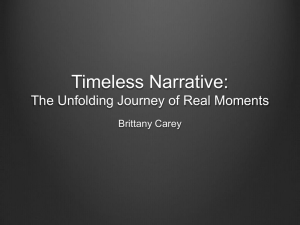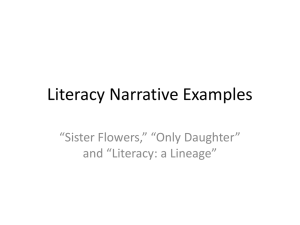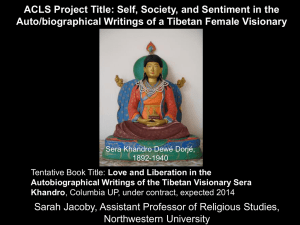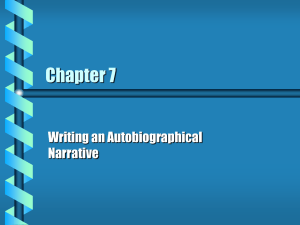LEARNING COMMUNITIES - Innovative Educators
advertisement
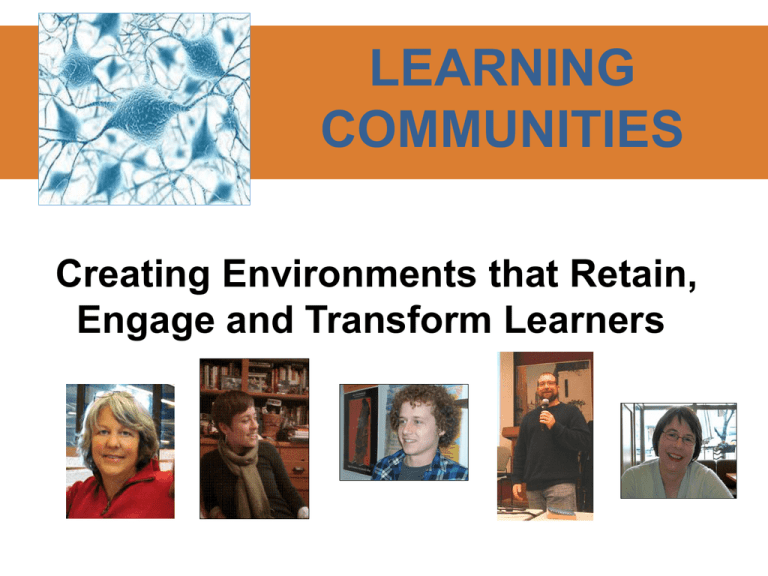
LEARNING COMMUNITIES Creating Environments that Retain, Engage and Transform Learners North Seattle Community College Presenters: * Jane Lister Reis, Communications Faculty * Haley Gronbeck, teaching assistant and tutor * Cam Basden, teaching assistant and adult learner * Chris McRae, adult learner * Carol Hamilton, Faculty Emeritus, English Foundations of our Learning Community Design: Supportive, Emergent, Co-Constructive & Based on Adult Learning Theory (Knowles) Carol Jane * Adults are practical, autonomous and self-directed. * Adults have accumulated a foundation of life experiences and knowledge that may include work-related activities, family responsibilities, and previous education. * Adults are goal-oriented and relevancy-oriented. * As do all learners, adults need to be shown respect. Conner, M. L. "How Adults Learn." Ageless Learner, 1997-2007. http://agelesslearner.com/intros/adultlearning.html LEARNING COMMUNITIES: A 20+ Year History at Our College * Requirement of AA degree since 1990s General Education Outcome: Integrated Learning * Research on student learning and retention in college and cohort community * Integrated Studies Committee led by a faculty member Faculty Development Connections/Collaboration/Cohesion Reasons for Integrated Learning Communities in the Curriculum For Student Learning & Retention: * Students find connections across disciplines * Learn to communicate in seminars through writing & discussion/ Ask “so what” in speaking and writing *Cohorts form, integrative assignments challenge, diversity explored through texts and purpose * Look at a public and relevant issue for their ongoing lives Theme/details for our course: “Beginnings: Sustaining Our Identity and Culture in a Multicultural Society” * An interdisciplinary 10-credit, 11-week evening course * Fall 2010 combining Freshman English Comp (ENGL 101- 102) * American Literature and Society (ENGL 265), * Small Group Communication (CMST&230) * Intercultural Communication (HUM105) Components of this Class: *Theme and Problem-based learning *Essays (personal narrative and research-based) *Dialogic student seminars *Mini-lectures *Small group discussions *Cultural interviews * Final integrative project that addressed a community issue All assignments can be found on the course website Understanding and Constructing the Classroom as Container Designing the elements of the course to help students experience the different levels of a container: 1. Politeness - Shared Monologues 2. Shared Experience -- Moving from ‘Me’ to ‘We’ 3. Reflective Dialogue – Inquiry & Analysis 4. Generative Dialogue – Making Meaning Together Container Concept as four quadrants from William Isaacs. Dialogue and The Art of Thinking Together, 1999. Introducing the Adult Learners & Teaching Assistants Our Educational Paths and How Learning Communities Changed our Learning and Our Lives Haley, Cam, and Chris Cam’s Narrative • My experience as both a student and T.A. in Coordinated Studies: its impact on my life both scholastically and privately. • Positive and negative experiences in online and hybrid classes; lack of personal connections and importance of human to human dialogue. • Communication and its importance inside and outside of the classroom. A Community That Cares • Establish awareness with students on the 1st day of class -this is not a normal class --you will be talking about deep issues revolving around identity, belonging, and community. • Create a sense of openness: student to student, teacher to student, and student to teacher all required for success and enjoyability. • Invite stories: All class members have a story, one that shapes our identity and our relationships with one another. • Discover empathy: it exists in all of us, but requires practice. • Recognize the class as a living system: it requires nurturing and attention in order for optimal learning to take place. In a community of care students move from separateness into a shared experience • Haley’s Narrative • Intersections between Scholarship of Teaching & Learning (SoTL) and my experience as a T.A. • My experience at The Evergreen State College: community-based, seminar-style learning with narrative evaluations • Practical applications of alternative learning • Diverse Learners: Exploring Personal Narrative and Social Awareness • Importance of narrative in the classroom to create a comfortable learning environment. • Creating a space where stories come forward. • Releasing your voice in the classroom: creating a space for student and teacher connection. • Using personal histories to challenge and deconstruct dangerous ideas. • Developing community and intellectual intimacy by understanding ourselves, our history, and the stories. around us.personal narrative and social awareness creates a space Exploring for reflective dialogue A COMMUNITY OF RELEVANT ENGAGEMENT Completing a project that addresses community stimulates scholarship and connection by performing the following functions: * Practical application of course material * Exercises analytical and critical thinking skills * Creates safe learning environment A COMMUNITY OF RELEVANT ENGAGEMENT * Empowers learners to take leadership and ownership * Fosters teambuilding skills * Develops connections * Provides quantifiable and visible service to the community A COMMUNITY OF RELEVANT ENGAGEMENT • Developing connections with each other and to the college that extend beyond the classroom. They build networks and support groups that can be used in future. • Providing a quantifiable and visible service to the community which gives the school value to the public and gives learners a sense of ownership to the school and their work. Relevant engagement creates opportunity for the discovery of new knowledge and meaning through generative dialogue Questions for Haley, Cam and Chris? Learning Communities: Build on Past Successes and Move to Future Reforms Assessment of learning communities: * Learning communities strengthen student retention and academic achievement * Transformative for both students and faculty * Research shows an integration of General Education outcomes makes sense to undergraduate students & returning older college students * New designs focusing on reforming pre-college Math and English curriculum (Gates Foundation grants and Washington Center projects) Learning Communities: Renewing Faculty Energy & Creativity Faculty Development: *Faculty at North have benefitted from Washington Center for Improving the Quality of Undergraduate Education at Evergreen State College (alternative curriculum reform for 30 years) *Faculty learning community (teams of 2-3 faculty create a course together)to purposefully integrate “disciplinary” outcomes * Workshops, conferences, mentoring, faculty exchanges and teams COURSE TOOLS & REFERENCES Course Website and Class Blog Key Handouts & Assignments (on course website): “So Do You Mean?” (Virginia Satir) “What’s in a Seminar” (Jim Harnish, faculty emeritus, NSCC) Seminar Video “Seminar: A Skill Everyone Can Learn" Seminar Preps (supports careful reading & critical thinking) Personal Narrative Assignment & Essay (creates value and respect) Cultural Interviews Assignment (listening, empathy & privilege exercises) Final Integrated Assignment (meeting a community need as a small group) Annotated Bibliography for Learning Communities (on blog) 20 Tips for Creating a Transformative Learning Community(on blog) FINAL QUESTIONS? Thank you for this opportunity to share our learning experience with you! CONTACT INFORMATION Jane Lister Reis jreis@sccd.ctc.edu Haley Gronbeck h.gronbeck@gmail.com Cam Basden cbass13@gmail.com Chris McRae cmcrae21@uw.edu Carol Hamilton chamilton@northseattle.edu
